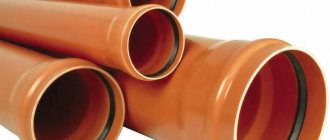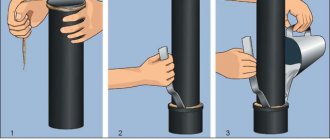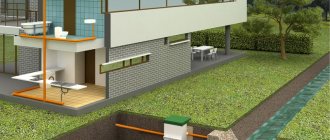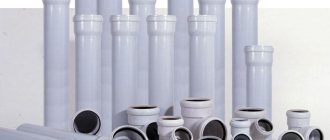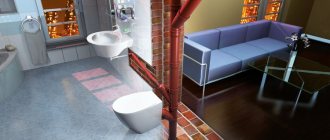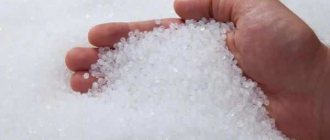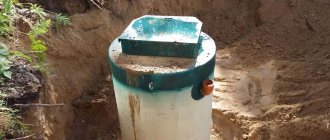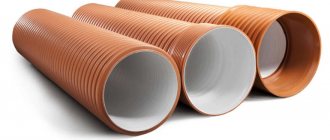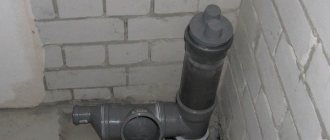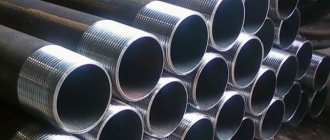The sewer system can be installed using pipes made of various materials. Steel, asbestos-cement, and ceramic channels have been replaced by plastic channels - easier to install and operate. There are internal and external sewerage networks. Since they operate under different conditions, the requirements for structural elements are different. PVC products are suitable for external systems, namely red sewer pipes.
Red-colored sewer pipes are used for the installation of external and internal drainage networks
What is the difference between the red sewer pipe and other varieties?
External installation of sewerage requires high resistance of products to temperature changes, and especially to the effects of negative temperatures. After all, being underground in frosty winter weather, which is so typical for our climate, can have a destructive effect on the material. The red pipe is characterized by increased frost resistance, as well as the following important characteristics:
- Increased rigidity;
- The walls are thick;
- Resistance to the aggressive environment of the transported liquid;
- Corrosion resistance;
- Chemical inertness;
- Long operational period.
Installation features
The ease of installation is determined by the fact that red pipes are mounted using a socket method and do not require welding.
Waterproofing is achieved through the use of seals, which are often already included in the product package. It is permissible to use a special sealant for plumbing in the absence of seals.
Note! It is worth taking care to pre-treat the ends of the pipe to clean the cut and create a stronger connection.
What material is used to make a red pipe?
The red pipe is made of high quality polymer material, which is superior to all other types of plastic in key indicators, such as rigidity and linear expansion.
Red sewer pipes
The red pipe for external sewerage can be smooth or corrugated, and the following material is allowed:
- Polyvinyl chloride (PVC);
- Polypropylene (PP);
- Polyethylene (PE).
Orange PVC sewer pipe is the best choice for an external wastewater transport system, provided that the fluid temperature does not exceed 60 degrees.
Polyvinyl chloride products can be used both for installing a new sewer network and for repairing an existing one. Due to the light weight of pipe products, they are easy to transport and install. You can cut the pipeline with an ordinary hacksaw, and joining does not require an expensive welding machine. All these qualities together have become the reason for the increased demand for red or red PVC pipes.
However, PVC, unfortunately, is not an ideal material and, like all others, has some disadvantages. Among the negative characteristics are the following qualities that a brick or red sewer main has:
- Deformation of the product when the wastewater temperature rises to 70 degrees or more;
- Destruction under the influence of organic solvents;
- Insufficient elasticity of the pipeline;
- The characteristics of the material are somewhat reduced in severe frost.
Pipes for external sewerage
Products made from polypropylene and polyethylene are more flexible and resistant to temperature changes. Polyethylene pipeline can be used either smooth or corrugated.
Advantages of PVC pipes
Red (from orange to brick-red) sewage products can withstand significant shock loads during installation or transportation. They have a low coefficient of linear stretching and expansion with temperature changes. In the absence of liquid inside, the communications do not crack even if they freeze completely.
The red polyvinyl chloride pipe, being underground, does not collapse and does not corrode. If the sewer network is laid correctly, then contamination of the channel is excluded. This is due to the smoothness of its inner surface, which ensures high speed of wastewater movement and prevents dirt deposition. As a result, the costs of maintenance and flushing of the entire system during operation are reduced.
The red pipe is easy to install, since its installation does not require the use of a welding machine, and for cutting you can use a regular hacksaw for metal.
Red-colored pipes are able to work effectively under heavy loads, so they can be laid underground without additional protection
Features of polypropylene and polyethylene pipelines for external networks
When it comes to polypropylene, its main advantage is its resistance to high temperatures. This material has no restrictions on the temperature of the transferred liquid, and in addition is suitable for both pressure and non-pressure systems. The elasticity of polypropylene is several times higher than that of PVC.
However, the most flexible line today is polyethylene. It is not afraid of freezing, because in case of slight deformation it can easily restore its shape. The best option for PE products for external laying is a two-layer red corrugated line, produced with a round cross-section of large diameter (from 110 mm).
Classification of red sewer pipes
The main classification characteristics for red PVC pipes include the production method, type of construction and degree of ring rigidity. Thus, according to the manufacturing method, products are divided into single-layer and multi-layer, according to the type of construction - pressure and non-pressure
Depending on the hardness category, the channels are:
- lightweight thin-walled structures (2 kN/m2, class L);
- medium-hard thin-walled products (4 kN/m2, class N);
- thick-walled rigid pipes (8 kN/m2, class S).
The red pipe of class L is used in laying sewer systems to a depth of up to two, class N - up to six and class S - up to eight meters.
Note! The indicator (category) of ring stiffness shows the value of the maximum permissible load per unit area of the product when its vertical diameter is deformed by 4%, not taking into account lateral resistance.
Pipelines are distinguished according to the amount of load, location and severity:
- heavy type (roads, industrial areas);
- medium type (areas of light traffic);
- light type (sidewalks, green areas).
There are also smooth and corrugated red pipes. The second type of product is multi-layered: the upper part is made of durable materials, the inner part is smooth and thin. Thanks to this design, the pipe acquires good elasticity and resistance to blockages.
There are also red-colored corrugated pipes; they are multi-layered and can withstand higher loads than smooth ones.
Pipe diameter for external sewerage
Pipes for external sewerage collect all waste water that flows from plumbing fixtures located inside the building, and therefore must have a large diameter. The selection of the pipeline diameter for external sewerage must be carried out in accordance with SNiP 2.04.03-85. Most often, a diameter of 110 mm is sufficient, but if the house is large, then it may be necessary to use products with a diameter of 160 mm. To drain wastewater from several houses into a common septic tank, it is recommended to use pipes with a diameter of 315 mm; here the standard 110 will not be enough.
Pipes for external sewerage 315 mm
The standard pipeline diameter for external sewerage is 110 mm.
Red PVC sewer pipe
Name — Red non-pressure PVC-U sewer pipe with socketApplication — red non-pressure PVC-U sewer pipes with a socket are used for the installation of external sewerage systems. PVC-U pipes are intended for organizing sewer systems of residential and public buildings, installation of intra-block networks, storm water installation, domestic, drainage system Manufacturer country - RussiaRegulatory document — TU 6-19-307-86Material — unplasticized polyvinyl chloride (UPVC) Color — red/orange (shades are not regulated) Working Wednesday - wastewater Pressure - no pressure Maximum operating temperature = + 60°C Accession - bell-shapedContents of delivery - with sealing ring Certificate of conformity (on request) Passport (on request) Price / price (on request)Specifications and Dimensions
Name
| Outer diameter ( mm ) | Wall thickness ( mm ) | Length ( mm ) | Weight , kg ) | Cost , rub. ) | |
| PVC-U sewer pipe red Dn 110 mm L = 1 m with socket | 110 | 3.2 | 500 | 0.70 | Price on request |
| PVC-U sewer pipe red Dn 110 mm L = 1 m with socket | 110 | 3.2 | 1 000 | 1.39 | Price on request |
| PVC-U sewer pipe red Dn 110 mm L = 2 m with socket | 110 | 3.2 | 2 000 | 2.78 | Price on request |
| PVC-U sewer pipe red Dn 110 mm L = 3 m with socket | 110 | 3.2 | 3 000 | 4.17 | Price on request |
| PVC-U sewer pipe red Dn 110 mm L = 4 m with socket | 110 | 3.2 | 4 000 | 5.56 | Price on request |
| PVC-U sewer pipe red Dn 110 mm L = 6 . 06 m with bell | 110 | 3.2 | 6 006 | 8.34 | Price on request |
| PVC-U sewer pipe red Dn 160 mm L = 1 m with socket | 160 | 4 | 1 000 | 3.45 | Price on request |
| PVC-U sewer pipe red Dn 160 mm L = 2 m with socket | 160 | 4 | 2 000 | 6.34 | Price on request |
| PVC-U sewer pipe red Dn 160 mm L = 3 m with socket | 160 | 4 | 3 000 | 9.41 | Price on request |
| PVC-U sewer pipe red Dn 160 mm L = 4 m with socket | 160 | 4 | 4 000 | 12.39 | Price on request |
| PVC-U sewer pipe red Dn 160 mm L = 6 . 08 m with bell | 160 | 4 | 6 008 | 18.35 | Price on request |
| PVC-U sewer pipe red DN 200 mm L = 1 m with socket | 200 | 4.9 | 1 000 | 5.27 | Price on request |
| PVC-U sewer pipe red DN 200 mm L = 2 m with socket | 200 | 4.9 | 2 000 | 9.78 | Price on request |
| PVC-U sewer pipe red Dn 200 mm L = 6 . 09 m with bell | 200 | 4.9 | 6 009 | 27.78 | Price on request |
Related products
| Lubricant for the assembly of PVC-U plastic sewer pipes and fittings | Non-pressure PVC-U pipes and fittings for internal sewerage, gray | PVC-U fittings for external sewerage, orange | PP-N free-pressure pipes and fittings for internal sewerage, gray | Plumbing clamps and studs |
Return to the on-line catalog >> can get advice , find out prices or fill out an application to buy this product by sending a request by e-mail to the address : proton . [email protected] . ru or by calling in Moscow : +7 (495) 641 16 85
PROTON LLC, Russia, Moscow, Andropova Avenue, 38 Official website: www.proton-st.ru, tel.: +7 (495) 641 16 85
Features of laying an external sewerage system
External and internal sewage systems are a single system that is responsible for ensuring comfortable living in a house or country house. The external network starts from the point where the pipeline exits the building and ends with a septic tank, cesspool or any other device for collecting and cleaning fecal matter. To successfully install an external system, the following recommendations should be taken into account:
- It is necessary to outline in advance a plan for the location of system elements on the site, to indicate the location of the septic tank and drainage well.
- Purchase the necessary materials in advance, and select a pipe diameter of at least 110 mm.
- The length of the red pipeline from a residential building to a septic tank must be at least 50 meters; this is the minimum distance from the house to the waste collection point.
- A 110 mm red pipeline should be laid below the soil freezing level, but above groundwater.
Installation of external sewerage
Peculiarities
Gray products are available in three modifications:
- SN 2. Lightweight parts of low strength. Wall thickness 2.3 mm;
- SN 4. Medium weight and strength. Walls from 2.5 to 12.3 mm (for large diameter components);
- SN 8. The heaviest and most durable products, the walls of which range in thickness from 3.2 mm to 15.3 mm.
The material for gray pipes is most often PVC or PP (polypropylene). There are plasticized and non-plasticized products. The former are lighter and softer, the latter are tough, durable, and their price is higher. Plasticity is the main property that distinguishes gray sewer pipes from orange ones. Since they work inside a building, a significant drop in temperature cannot be expected. However, gray pipes can easily withstand the flow of hot water (kitchen sink, dishwasher), which red sewer pipes cannot withstand. In addition, the internal sections of the system experience virtually no external loads or mechanical impact. Therefore, they are not made too strong - this is impractical and will unjustifiably increase the cost of production. However, the parameters of the pipelines make it possible to freely tolerate the impacts that arise during the operation of drainage systems. There were no cases of rupture or deformation of internal parts during proper use.
Installation of sewer pipes
Red plastic pipes with a diameter of 110 mm are characterized by increased ease of installation. Their light weight and the absence of the need to use special equipment make it possible to carry out work even without experience in this field. To lay a 110 mm pipe you will need to perform the following steps:
- Dig trenches on the site according to the sewer system layout plan. For ease of installation work, the width of the trench should slightly exceed 110 mm - the diameter of the pipeline.
- The bottom of the trench should be filled with a sand and gravel cushion.
- On sandy soils, an additional layer of geotextile is also laid.
- In places where the direction of the pipeline changes, with a significant difference in height, as well as on an equal section, inspection wells are installed every 6 - 12 m.
- Elements of a red PVC pipe with a diameter of 110 m are connected end-to-end without a gap using the socket method, which significantly speeds up installation.
- The smooth edge of the pipe is inserted into the socket until it stops, and then extended 10–15 cm. This avoids deformation due to temperature fluctuations.
- When installing brick-red PVC mains, no additional expansion joints are required.
- In places where the sewer system branches and turns, red polyvinyl chloride fittings are used.
- The sewer pipeline is connected to the septic tank, this is its end point.
- It is necessary to dig trenches in the same sequence: first you need to lay out a layer of sand, and only after that the earth.
- These actions will reduce the influence of heaving forces on the sewer system.
- After installation, the sewer network is checked for leaks.
Connection of sewer pipes
How to store
Important! It is necessary to store red sewer pipes without subjecting them to mechanical stress of any mechanisms or equipment. Stored in unheated areas. If there are heating devices in the warehouse, keep them at a distance of at least 1000 millimeters from them.
Depending on the technologies used in the manufacture of red sewer pipes with a diameter of 160 mm, they are:
- Single layer.
- Three-layer, having an inner layer of recycled foam material and outer layers of non-plasticized polyvinyl chloride.
Depending on the degree of ring rigidity of the red sewer pipe, it is divided into:
- 2 kN/m – L.
- 4 kN/m – N.
- 8 kN/m – S.
They are produced in lengths of 1000-6000 millimeters and have a diameter of 110-500 millimeters (a red sewer pipe with a diameter of 160 mm is the most common), and a pipe wall thickness of 3.2-14.6 millimeters.
Depending on the manufacturer, their colors range from orange to brick red.
Gray pipes
They are used indoors, where there is no strong mechanical and temperature influence. The manufacturing material is polypropylene. Gray pipes are designed for the temperature of the liquid passed through them within 60-75 degrees. However, they can withstand a short-term increase in the indicator to 90-95 degrees. The external temperature should not fall below 0°.
They are characterized by chemical inertness: there are no corrosive processes and no release of harmful substances.
Since deformation occurs with a relatively small force - 50-75 kgf/m2, it is not recommended to install such pipes in places where external pressure will be exerted on them. Use for external sewerage is justified only by financial savings, which, however, may result in the need to dig a trench and replace the entire drain.
Polypropylene pipes for internal installation
Gray PP pipes are used for installation inside the house, from the drain holes to the circuit. Such elements are single-layer, standard wall thickness is 1.8 and 2.7 mm, diameter is 50 and 110 mm, respectively. Smaller diameter pipes are convenient for drainage from household appliances (washing machines, dishwashers, split air conditioning systems), while wider ones lead to plumbing fixtures.
Gray pipes and fittings in our catalog
Fan pipe for internal sewerage
Oblique sewer tee
Sliding coupling
90 degree cross
The main advantage is that the polymer material can withstand the temperature of the transported medium +95°C without deformation and is not prone to fire or rotting. Gray PVC-PP pipes do not have good sound absorption (for silent sewerage, white analogues are purchased), they expand when heated, and are installed only with a sealing gasket, otherwise there will be leaks when disposing of hot water. Gray plastic pipes are not suitable for laying in the ground due to their low resistance to shock and static loads and can burst under the pressure of the earth.
Requirements for external pipelines
External sewer networks have to function in difficult conditions. Pipes covered with earth are forced to bear the weight of the soil, on which people, and often cars, can move.
They are also affected by soil water, which can provoke a displacement of the connecting points, which can lead to depressurization of the sewer network.
Systems must constantly withstand the static/dynamic effects of wastewater transported through pipes.
That is why special requirements are imposed on elements of external sewer networks.
Pipes must have the following qualities:
- strength and rigidity;
- the ability to withstand temperature fluctuations without losing performance;
- frost resistance;
- wear resistance, long service life;
- resistance to aggressive chemical environments.
For the manufacture of external sewer systems, various materials can be used (polymers, steel, cast iron), but they all must comply with the above factors.
It should also be taken into account that the quality of the pipeline is influenced not only by the specific properties of the pipes, but also by the quality of installation and laying of the system.
Our website also has other useful materials on sewerage rules.
We recommend that you familiarize yourself with them:
- Laying sewer pipes in the ground: technological rules and nuances
- Calculation of sewer slope: formulas and standards
- How to lay sewer pipes in a private house: laying diagrams and rules + installation stages
Inside or outside?
It's quite simple: by using different colors of plastic, pipe manufacturers help customers distinguish between them. If it is planned to install a sewer system inside the building, then the color of the pipes suitable for this is gray. And the pipe for the external sewage system is red.
Internal and external sewer pipelines differ significantly in their characteristics. The main line for drainage must have greater capacity than the pipes inside the house, and also have the following characteristics:
- high degree of rigidity;
- fairly thick walls;
- resistance to chemicals, caustic components of household waste, corrosion;
- long service life.
Thanks to polymer materials, the red sewer pipe has all the qualities listed above.
Installation nuances
Installing an external sewer system in your home using socket elements is simple and easy to do with your own hands.
Installation of an external sewerage network
Long external sewers must have inspection wells. The distance between them should not exceed 50 meters; only one turn of the pipeline is allowed between them. This is done so that the system is accessible for cleaning.
Laying is done from the well (or collector, or septic tank).
Features of channel installation
The most labor-intensive part of the work is excavation work. The optimal trench width is 25-30 cm. It is advisable to hire a trench excavator (“bar”). There are also small-sized excavators with trenchers and machines for cutting ditches. You can do it the old fashioned way - by hand. Wide places are excavated near the walls of the house and near the wells; the rest of the trench should be as narrow as possible (saves effort and sand). All turning points must be located in dry manholes large enough to allow a person to descend and operate the turning point.
Sand 10-15 cm thick is poured onto the bottom of the trench, compacted using a tamper, and a slope of 2-8 mm per linear meter is arranged.
How to properly lay sewer pipes in a country house
The socket of the last pipe of the external system must be located inside the foundation and must be insulated. Before joining the two elements, rubber cuffs are lubricated with silicone sealant to increase the tightness.
The pipeline should not bend up or down, and there should not be strictly horizontal sections. Having assembled the system, it is tested and insulated. Then they are covered with a layer of sand 100-150 mm thick, lightly compacted and filled with water (for compaction). Pour the soil into the trench, lightly compact it, and spill it with water.
Do not greatly exceed the slope for external sewerage - this will lead to a strong deepening of the trench and an increase in the volume of excavation work.
Circuit installation tips
It is impossible to increase or decrease the slope, especially of external sewerage. This leads to solids retention and blockages. It is not advisable to clean the drain using chemicals or pour out hot water - this can damage the system.
The minimum depth for laying the pipeline is 30 cm above the soil freezing level. In this case, the sewerage system will require insulation. Such a pipeline must be insulated. They use penofol - sheets of foamed polyethylene covered with foil; polystyrene foam shells. You cannot use mineral or glass wool because of their hygroscopicity.
Material Definition
Red pipes are made from cross-linked polyethylene. Previously, there was a skeptical attitude towards this definition. Now what remains in my memory is also not exactly what these products mean now. Cross-linked polyethylene is presented as a pipe product with a longitudinal seam, which has the advantage of low cost. However, the quality leaves much to be desired.
But this is not true at all. A modern red HDPE pipe is a high-tech invention that, in terms of its performance properties, competes well with other types. Modern construction and renovation work rarely goes without this type. In addition, red pipes are increasingly used for heated floors.
So why is it called “cross-linked polyethylene”? Everything happens at the molecular level. It is the polymer molecules that are cross-linked using special equipment, which ultimately produces a strong and durable material for making pipes. Special physical and chemical processes are involved in production.
Red pipes are made from several types of derivatives of the material obtained in different ways, namely:
- PE-Ha – formed during heat treatment using peroxides;
- PE-Xb - obtained as a result of moisture treatment using implanted silane and catalytic substances;
- PE-Xs - produced by exposing molecules to electrons;
- PE-Хd – obtained when exposed to nitrogen.
The main technical properties are precisely laid down at the molecular level. Thanks to strong bonds, it is almost impossible to break the material.
